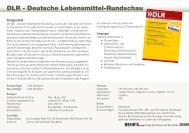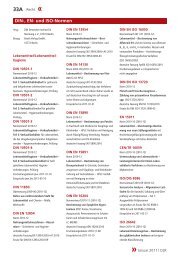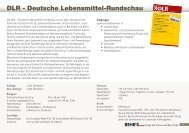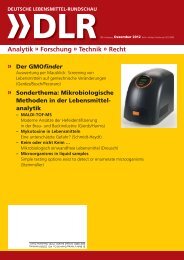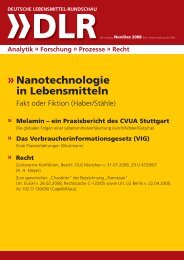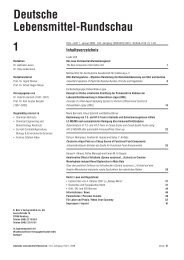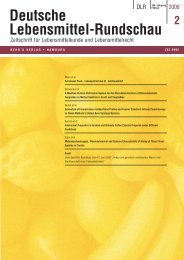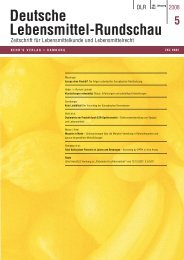Recht - DLR Online
Recht - DLR Online
Recht - DLR Online
Erfolgreiche ePaper selbst erstellen
Machen Sie aus Ihren PDF Publikationen ein blätterbares Flipbook mit unserer einzigartigen Google optimierten e-Paper Software.
initial fertilization, the second two weeks before the natural<br />
June drop, and third after fruit picking. The cumulative rate<br />
of nitrogen in this case reached 105 kg N/ha. Nitrogen fertilization<br />
was equal in all years of the experiment.<br />
b) Crop load regulation<br />
Trees were selected according to their vegetative (trunk circumferences)<br />
and generative parameters (number of flower<br />
clusters, number of fruit after the natural June drop). In all<br />
years of the experiment fruits were thinned by hand at a<br />
diameter of 15 mm to the chosen crop load (CL: number of<br />
fruit per tree) of 100 % (H: high), 70 % (M: moderate) or<br />
40 % (L: low) of potential ceop load (yield).<br />
c) Fruit sampling and quality characteristic determination<br />
On each selected tree 4 fruits were chosen and marked by a<br />
code, which consisted of the nitrogen rate, crop load, block<br />
replication and number of fruits in the treatment (for instance:<br />
N60-H-2-12). Fruit samples were taken from the 2 nd<br />
to 4 th growing year (1999 to 2002) and were tested for skin<br />
colour, fruit flesh firmness, soluble solids content, starch<br />
degradation index, titratable acidity content and fruit mineral<br />
composition.<br />
d) Skin colour measurement<br />
In the years 2001 and 2002 skin colour measurements were<br />
performed. Sign L, marked on each selected fruit, represented<br />
the exact spot where the colour was measured. This<br />
method is a modification of the method, used by Tijskens<br />
et. al (2003) for determination of chlorophyll degradation<br />
dynamics in stored fruits.<br />
A Minolta CR-200 chomameter linked to DATA DP 100<br />
for data processing was used for skin colour measurement.<br />
Fruit chromaticity was expressed in L* a* b* colour space<br />
coordinates (CIELAB). L* correspondes to a dark/light<br />
scale (0 = black, 100 = white) and represents the relative<br />
lightness of colours, being low for dark and high for light<br />
colours. The parameter a* is negative for green and positive<br />
for red and b* is negative for blue and positive for yellow<br />
(Hribar, 1989). L*a*b means were presented as:<br />
L* = 116(Y/Yn) 1/3 – 16 (1)<br />
a* = 50[(X/Xn) 1/3 – (Y/Yn) 1/3 ] (2)<br />
b* = 200[(Y/Yn) 1/3 – (Z/Zn) 1/3 ] (3; Hribar, 1989).<br />
The absolute colour difference between two measurements<br />
was calculated as:<br />
ΔE = (Δa* 2 +Δb* 2 +ΔL* 2 ) 1/2 (4)<br />
ΔL = L*– L* n-1<br />
(5)<br />
Δa* = a*– a* n-1<br />
(6)<br />
Δb* = b*– b* n-1<br />
(7; Hribar, 1989).<br />
The initial colour measurement was made approximately<br />
1 month before the predicted technological maturity of<br />
fruits and continued up to the time of technological maturity<br />
of the fruits.<br />
e) Fruit maturity parameters<br />
The fruit were collected at the optimal harvest date. 30 fruit<br />
per treatment (10 per block) were selected for determination<br />
of fruit maturity parameters.<br />
Fruit flesh firmness was measured by a hand penetrometer<br />
using a FRUIT PRESSURE TESTER mod. HT 327 (3–27<br />
Lbs., 11 mm) at 4 spots on the equatorial cross-section<br />
of the fruit, after removing the fruit skin (Hribar, 1989).<br />
Means are expressed as kg/cm 2 . Soluble solids in apple<br />
juice were measured by an ATAGO N1 hand refractomeret<br />
and expressed as % Brix. The starch degradation index<br />
was defined after dipping a cross-section of the fruit<br />
into a 0,02 M solution of I 2 in potassium iodine (KI),<br />
where the presence of starch results in a dark coloration of<br />
the fruit-cross-section. The intensity and % of coloration<br />
were determined according to the EVROFRU starch scale,<br />
where unity 1 represents 100 % of unconverted starch in<br />
the fruit.<br />
Then the Streif maturity index was calculated:<br />
STI = F/SSxS (8; Streif, 1996)<br />
F: fruit flesh firmness, SS: soluble solids, S: starch<br />
Total titratable acidity were measured by titration of apple<br />
juice with 0,1 M NaOH using phenolphthalein as indicator<br />
and expressed as malic acid.<br />
f) Mineral composition of fruits<br />
After picking the fruit were grated with a plastic grater and<br />
frozen at –20 °C. Total fruit nitrogen content was determined<br />
according to the Kjedahl method and Ca content by<br />
means of atomic absorption spectroscopy.<br />
Statistic evaluation<br />
One way variance analysis was used to determine the influence<br />
of nitrogen rate and crop load on the different parameters<br />
of fruit quality. Duncan’s test (0.05) was used to determinate<br />
differences between treatments. For processing of<br />
statistical data the Statgraphic Plus 4.0 (Manigistics, ZDA)<br />
package was used.<br />
Results and Discussion<br />
a) Fruit skin colour<br />
The results in Table 1 show that nitrogen rate and crop<br />
load significantly influenced the chromometric parameters<br />
Tab. 1 Source of variability and their influence on chromometric parameters<br />
L*a*b* with adjusted P-values and determination coefficient (R2)<br />
Parameter N CL Y N x CL x Y R2<br />
L* < 0.0001 < 0.0001 0.0458 < 0.0001 0.24<br />
a* < 0.0001 < 0.0001 < 0.0001 < 0.0001 0.32<br />
b* 0.0009 < 0.0001 0.0002 < 0.0001 0.30<br />
P ≤ 0.001: very highly significant; P ≤ 0.01: highly significant; P ≤ 0.05: significant;<br />
P > 0.05: not significant (N: nitrogen, CL: crop load, Y: year)<br />
128 ı Originalarbeiten Deutsche Lebensmittel-Rundschau ı 104. Jahrgang, Heft 3, 2008




